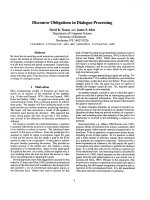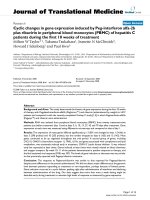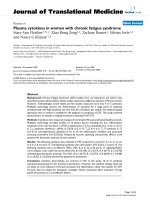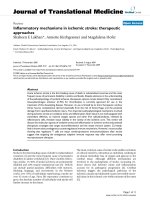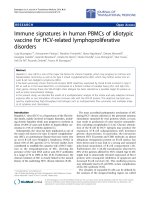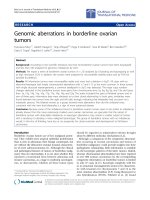Báo cáo hóa học: " Reproducible research in signal processing" doc
Bạn đang xem bản rút gọn của tài liệu. Xem và tải ngay bản đầy đủ của tài liệu tại đây (144.78 KB, 2 trang )
EDI T O R I A L Open Access
Reproducible research in signal processing
Markus Rupp
1*
, Fulvio Gini
2
, Ana Pérez-Neira
3
, Beatrice Pesquet-Popescu
4
, Aggelos Pikrakis
5
, Bulent Sankur
6
,
Patrick Vandewalle
7
and Abdelhak Zoubir
8
Reproducible research results become more and more an
important issue as systems under investigati on are grow-
ing permanently in complexity, and it becomes thus
almost impossible to judge the accuracy of research results
merely on the bare paper presentation. The precise defini-
tion of reproducibi lity varies across disciplines, but it is
often closely related to the definitions of repeatability and
replicability. In a recent encyclopedia of philosophy of
science, reproducibility is described as the repeatability of
the process of establishing a factor of the conditions under
which the same fact can be observed. In natural science,
reproducibility is often related closely to the repeatability
of experimental conditions and results.
EURASIP became more and more interested in this
issue in particular as some of the EURASIP journals
would like to make reproducibility an important factor
for accepting a submitted paper and by this increase the
quality of the papers and in consequence of the entire
journal. First trials were not very successful and the idea
was born to offer a special issue not focused on any DSP
subject but just on the concept of reproducibility. By thi s
it would be possible to recognize which fields in DSP are
better suited.
We therefore devoted this special issue of the EURASIP
Journal of Advances in Signal Processing particularly to
research results in signal p rocessing that can be proven
to be reproducible. In particular, we expected that the
code and the companion data in the submitted paper will
beavailablebytheauthorsatsubmissiontimetobe
checked as part of the review process. If the paper is
accepted for publication, then the software must be pro-
vided for downloads. Though source code is preferred,
the authors must prepare a working object code. In order
to facilitate reproducible results, we expected that all
codes are provided to reproduce the various tables and
figures in the paper. Furthermore, we expect that the
code is well documented and a permanent email address
as point of contact shall be provided possibly also with a
permanent webpage so that fellow researchers can refer
tosomeoneiftheyhavequestionsorsimplyreportbugs
they found. It would also be good to see additional test-
ing material that was used to evaluate the correctness of
the code.
Despite our high expectations at the end only 4 papers
were accepted the reason being that among the 31 sub-
missions most papers were immediately rejected as they
did not show any sign of reproducibility at all. The
finally accepted papers were
In the paper entitled “A Full Bi-tensor Neural Tractogra-
phy Algorithm Using the Unscented Kalman Filter,” coau-
thored by Stefan Lienhard, James Malcolm, Carl Frederik
Westin, and Yogesh Rathi, a technique for visualizing
neural pathways in human brains by extending an existing
framework which uses overlapping Gaussian tensors to
model that the signal is described. At each point on the
fiber an unscented Kalman filter is used to find the most
consistent direction as a mixture of previous estimates and
of the local model. Experiments on synthetic data show a
reduction of the angular error at fiber crossings and
branchings. Tests on in vivo data demonstrate the ability
to trace fibers in areas containing crossings or branchings,
and the tests also confirm the superiority of using a full
tensor representation over the simplified model.
In “Internet-based Hardware/Software Co-design
Framework for Embedded 3D Graphics Applications,” by
Chi-Tsai Yeh, Chun-Hao Wang, Ing J. Huang, and Weng-
Fai Wong, a hardware/software co-design environment for
3D graphics application development is proposed that
includes the 3D graphics software, OpenGL ES application
programming interface (API), device driver, and 3D gra-
phics hardware simulators. A 3D graphics system-on-a-
chip (SoC) accelerator was developed using t ransaction-
level modeling (TLM). This gives software designers early
access to the hardware even before it is ready. On the
other hand, hardware designers also stand to gain from
the more complex test benches made available in the soft-
ware for verification. A unique aspect of the framework is
that it allows hardware and software designers from
* Correspondence:
1
Institute of Telecommunications, Vienna University of Technology, Vienna,
Austria
Full list of author information is available at the end of the article
Rupp et al. EURASIP Journal on Advances in Signal Processing 2011, 2011:93
/>© 2011 Rupp et al; licensee Springer. This is an Open Access article distributed under the terms of the Creative Commons Attribution
License ( which permits unrestricted use, distribution, and reproduction in any medium,
provided the origin al work is properly cited.
geographically dispersed ar eas to cooperate and work on
the same framework. Designs can be entered and executed
from anywhere in the world without full access to the
entire framework, which may include proprietary compo-
nents. This results in controlled and secure transparency
and reproducibility, granting leveled access to users of
various roles.
In “The Vienna LTE Simulators–Enabling Reproducibil-
ity in Wireless Communications Research,” by Christian
Mehlführer, Josep Colom Ikuno, Michal Šimko, Stefan
Schwarz, Martin Wrulich, and Markus Rupp, a MATLAB-
based link and system level simulation environment for
UMTS Long Term Evolution (LTE) is proposed. The
source codes of both simulators are available under
an academic non-commercial use license, allowing
researchers full access to standard-compliant simulation
environments. Owing to the open source availability, the
simula tors enable reproducible research in wireless com-
munications and comparison of novel algorithms. The link
and system level simulations are connected a nd the link
level simulator serves as a reference to design the system
level simulator. The accuracy of the PHY modeling at sys-
tem level is validated by means of simulations, performed
both with bit-accurate link level simulations and PHY-
model-based system level simulations.
In “Reproducible LTE Uplink Performance Analysis
using Precomputed Interference Signals,” by Volker Pauli,
Muhammad Danish Nisar, and Eiko Seidel, the use of rea-
listic precomputed interference patterns is proposed for
LTE uplink performance analysis and testing. The interfer-
ence patterns are generated via an LTE system-level simu-
lator for a given set of scenario parameters, such as cell
configuration, user configurations, and traffic models. The
generat ed interference patterns (some of which are made
publicly available) can be employed to benchmark the per-
formance of any LTE uplink system in both lab simula-
tions as well as field trials for practical deployments. It is
worth mentioning that the proposed approach can also be
extended to other cellular communication systems
employing OFDMA-like multiple access with frequenc y-
select ive RRM techniques. The proposed approach offers
twofold advantages. First, it allows for repeatability and
reproducibility of the performance analysis. This is of cru-
cial significance for researchers and developers for analyz-
ing the behavior and performance of their systems, and
also for the network operators to compare the perfor-
mance of competing system vendors. Second, the pro-
posed testing mechanism evades the need for deployment
of multiple cells (with multiple active users in each) to
achieve realistic field trials, thereby resulting in significant
cost (and time) savings in the field trails.
Author details
1
Institute of Telecommunications, Vienna University of Technology, Vienna,
Austria
2
Department of “Ingegneria dell’Informazione”, University of Pisa, Pisa,
Italy
3
Department of Signal Theory and Communications, Technical
University of Catalonia (UPC), Barcelona, Spain
4
Télécom ParisTech, Paris,
France
5
Department of Informatics, University of Piraeus, Piraeus, Greece
6
Bogazici University, Bebek, Istanbul , Turkey
7
Liege Area, Belgium
8
Signal
Processing Group, Darmstadt University of Technology, Darmstadt, Germany
Received: 28 August 2011 Accepted: 27 October 2011
Published: 27 October 2011
doi:10.1186/1687-6180-2011-93
Cite this article as: Rupp et al.: Reproducible research in signal
processing. EURASIP Journal on Advances in Signal Processing 2011 2011:93.
Submit your manuscript to a
journal and benefi t from:
7 Convenient online submission
7 Rigorous peer review
7 Immediate publication on acceptance
7 Open access: articles freely available online
7 High visibility within the fi eld
7 Retaining the copyright to your article
Submit your next manuscript at 7 springeropen.com
Rupp et al. EURASIP Journal on Advances in Signal Processing 2011, 2011:93
/>Page 2 of 2
